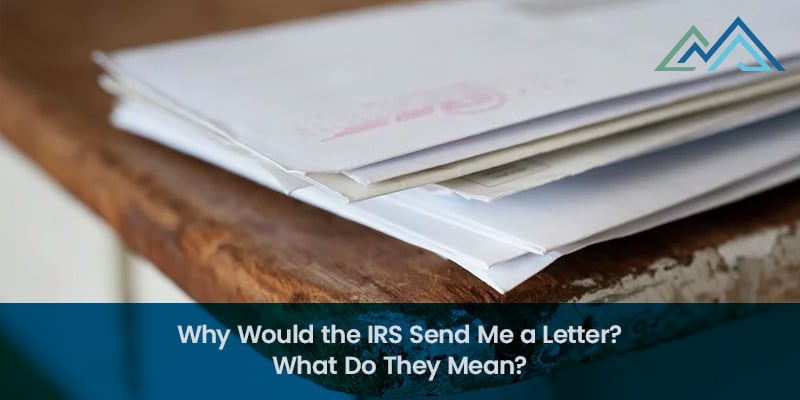Nobody wants to hear from the Internal Revenue Service. We want to pay our taxes, file our returns, get a tax refund, and never talk to the IRS. Since that’s not always possible, it’s important to know what to do when you receive an IRS letter.
At CMP, we help our clients with tax issues every day. In this guide, we’ll explain what IRS letters are, why they’re sent, the various types of letters, and what to do if you receive one.

What is an IRS Letter?
IRS letters are notices to taxpayers that there’s an issue with their taxes. It may be something simple or something complex, but ignoring a letter from the IRS is never advisable.
If the IRS needs to communicate with you, they’ll do so in letters by mail. The IRS sends letters to the mailing address they have on file, and they won’t communicate in any other way. It’s not uncommon for scammers to pretend to be IRS agents, so be wary of any communication that’s in another format, such as an email, text, or phone call.Why Would the IRS Send Me a Letter?
Let’s start with what the IRS says about the letters they send.
Most IRS letters and notices are about federal tax returns or tax accounts. Each notice deals with a specific issue and includes any steps the taxpayer needs to take. A notice may reference changes to a taxpayer's account, taxes owed, a payment request, or a specific issue on a tax return. Taking prompt action could minimize additional interest and penalty charges.
The IRS may send you a letter because there’s a correction to be made to your federal tax return because you owe money or because there’s been a change to your account.
Types of IRS Letters
There are several types of letters you might receive from the IRS. Here are some of the most common.
CP2000 Notice of Proposed Adjustment
The CP2000 is the most common letter sent by the IRS. It’s a notice that there’s a discrepancy between the income you reported on your tax return and what your employer(s) reported.
The CP2000 may mean you have to pay the IRS. It could also mean that you’re getting a refund.
CP2501 Tax Return Discrepancy
The CP2501 is a notice that indicates a discrepancy between the information on your tax return and what the IRS has on file. It won’t necessarily impact the amount of tax you owe.
You’ll have 30 days to respond to a CP2501 and correct the discrepancy.
CP75A Notice Request for Taxpayer Identification Number and Certification
A CP75A notice is what the IRS sends when they’re auditing your federal tax return and requires confirmation of certain information.
- Your filing status
- Your dependents
- Data supporting the Earned Income Credit
You’ll receive forms with this letter, which you should fill out promptly and return with supporting documentation.
CP90/CP297 Notice of Balance Due or Payment Request
A CP90 or CP297 letter is a notice that the IRS intends to levy your wages to satisfy an unpaid balance.
If you receive a levy notice, you’ll have two options. The first is to pay what you owe. The second is to contact the IRS and request a payment plan.
CP161 Unpaid Taxes or Contact Stub for Department Manager's Office or LT16 Notice
Both CP161 notices and LT16 notices are letters informing you that you’ve got a balance of unpaid taxes.
You’ll receive documentation showing how the IRS calculated the amount you owe. You should compare the documentation to the calculations you made for your tax return and either pay the amount owed or dispute it.
CP3219N or CP12 Deficiency or Adjustment Notices of Tax Issues
CP3219N and CP12 notices have a few things in common. The former is a notice that the IRS hasn’t received your tax return. You’ll have 90 days to file or dispute the assessment in tax court.
A CP12 notice is a notice that the IRS has corrected at least one mistake on your tax return. If you’re getting a refund and you agree with the notice, you can wait 4–6 weeks, and you’ll get your refund. If you disagree or owe money, you have 60 days to respond and dispute the assessment or set up a payment plan.
LT11 or L1058 Notice to Pay Overdue Taxes
If you receive an LT11 or L1058 notice from the IRS, you’ll need to act immediately if you want to avoid the IRS seizing your property to satisfy your past-due balance.
You’ll have the option of paying your balance online or, if you owe less than $50,000, setting up an installment plan. Keep in mind that if you miss a payment, your property may still be seized.
CP501 & CP502 Balances Due Notice for Unpaid Taxes
If you receive a CP501 or CP502 notice from the IRS, it means you have a past-due balance. This notice is your first warning that the IRS will undertake collection actions, up to and including a tax levy, to get what you owe them.
The CP502 is a second warning that your balance remains unpaid and will be sent if you don’t respond to the CP501. It’s an escalation, but there’s still time to pay your balance and avoid a levy.
CP503 Intent to Levy and Right to a Hearing
The CP503 is your third warning and represents an opportunity to pay your balance in full or call to arrange a payment plan. You also have the right to dispute the balance owed.
If you fail to respond to a CP503, the IRS could issue a tax lien or tax levy to collect the balance owed.
CP504 Final Notice Before Lien or Levy
A CP504 notice is your final opportunity to avoid a tax lien or levy. If you’re collecting Social Security, the IRS can levy your Social Security payments.
If you receive a CP504 letter, you must either pay the amount due immediately, request a payment plan, or make an appeal to the Collection Appeal Program.
Understanding Letters From The IRS
When you get a letter from the IRS, don’t panic. Here are some tips to help you understand your letter.
Key Information to Look For
Look for these items in your letter.
- The LTR or CP number should appear at the top or bottom right of the letter. You’ll need this information to understand why the IRS is contacting you.
- The contact number will appear at the top right-hand corner of the notice.
- You’ll see an address if you choose to respond by mail. It may take up to 30 days for a response.
- Additional information related to the specific issue, e.g. an adjustment to your tax return or an amount owed.
Different Sections of an IRS Letter Explained
There are a few key areas you should understand when you receive a letter or notice from the IRS.
There’s a box at the upper right-hand corner or bottom right corner. It should include the type of notice you’ve received, the date of the notice, the tax year the notice pertains to, the type of notice you’ve received, your personal taxpayer information, and information about how to pay outstanding balances.
If you owe money, you may see a billing summary on the first page. This section outlines the total federal taxes owed, the amount you’ve already paid, and any late fees or penalties that you’ve accrued.
There may be more than one page in the notice you receive. It’s common for the second and subsequent pages to contain detailed information on how you should proceed. That includes the amount owed, where to remit payment, a contact phone number, and information about future penalties and fees if you don’t pay what’s owed.
Keep in mind that different notices and letters may have slightly different formats. If you need help understanding an IRS letter, we recommend talking to a tax professional.
What to Do When You Receive an IRS Letter
There are some simple steps you should take when you receive an IRS letter.
Steps to Take Upon Receiving IRS Correspondence
If you get an IRS letter, timely action is a must. Follow these steps.
- Don’t panic.
- Read the letter completely.
- Review the information and compare it to your tax return.
- If you agree with the suggested changes, note them on your return and file the letter with your tax records.
- Take any requested action as soon as possible. Actions may include making a payment, requesting an installment agreement, or filing a dispute.
- Advise the IRS of disputes immediately.
- Contact the IRS only if it’s necessary.
If you agree with the changes and there’s no balance due, you can simply file the letter with your corrected tax return.
When and How to Respond to IRS Letters
Responding to an IRS letter may be simple. If you owe money and can afford to pay it immediately, the only action required is to pay it.
If the IRS is requesting information from you, you’ll need to provide it as quickly as possible. For example, you might need to correct your address or other personal information.
If you want to dispute the information in the letter or require a payment plan, you’ll need to contact the IRS: the Independent Office of Appeals if you have a dispute, and this page if you want to request a payment plan.
Seeking Professional Advice
There may be times when it’s wise to consult a tax professional or accountant after you receive an IRS letter.
When to Consult a Tax Professional or Accountant
There are some issues that you may be able to resolve on your own. If you owe a small balance and can afford to pay, you don’t need a tax professional to help you.
You should consult an accountant or tax professional if you don’t understand the letter you received, you can’t afford to pay, or you’re being audited. In these cases, it’s important to have a professional by your side to walk you through the process and avoid costly mistakes.
Benefits of Professional Guidance in Responding to IRS Letters
There are some significant benefits to getting professional guidance in responding to IRS letters, including the following.
- You can be sure that you understand the letter and what you need to do.
- You can get help negotiating reductions in fees and penalties.
- You can be sure you provide the proper information in response.
- A tax pro or accountant can help you set up a payment plan you can afford.
- You won’t need to worry about making mistakes.
If you’re worried about any of these things, you may want to consider working with a tax professional.
Get the IRS Help You Need from Our Tax Pros
Receiving a letter from the IRS can be scary, but it’s important not to panic. You can use the information here to understand the letter and take the necessary steps.
Do you need professional guidance with an IRS letter? Our tax professionals are here to help! Contact us and schedule a free consultation today.

















